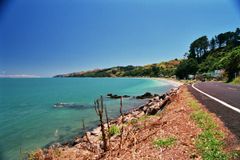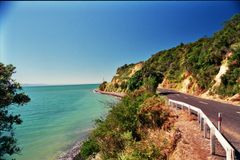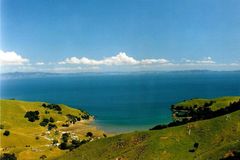The Coromandel West Coast
Papakura to Clevedon
Leave the station, cross the rail bridge and take the Clevedon road out of Papakura. This will wind through the suburbs for about two kilometres. Then you are into rolling hills and farmland. Clevedon, the first town you reach, is a small town with dairies, cafés, pub and an organic shop. No campground or hostel.
Clevedon to Kawakawa Bay
This is pretty, lightly undulating countryside with an intermittent shoulder along sealed country roads. After ten kilometres you will get your first glimpse of the sea as you approach the coast with the Hauraki Estuary to your left. Kawakawa Bay appears just as you breast the hill. Here amongst this blue loveliness is a store, takeaways and a garage. I have asked for, and been given permission, to camp on the beachfront here on two occasions. There is nothing like fish and chips and watching the sunset. But be mindful, it pays to ask and not assume you can free camp.
Kawakawa Bay to Ōrere Point
This is your first hill of any consequence. Turn left after the store and then follow the road as it gradually winds upward through native bush away from the sea. After a few rises and falls the road curves to the right and Ōrere Point is well signposted to your left. This is your first official camp site with a reasonably well-stocked store. The campground has good facilities set among native bush. The camp includes a beach close by and a clean river with a swimming hole.
Ōrere Point to Kaiaua
The road continues to climb through bush and farmland and winds down eventually to the coast. From here you cycle along a lovely coastal road, generally flat but with little shoulder. The traffic should be fairly light however. Eleven ks from Ōrere Point you will come to Waharau Regional Park on your right. Although this looks like a DOC camp you need to book to use it apparently.
The road is generally flat from here to Thames passing quarries, coastline and bird sanctuaries. As you come into Kaiaua there is a store, pub and takeaway shop. Kaiaua has two campgrounds but they are only open intermittently. I suggest your best bet is to continue a bit further to Miranda.
Kaiaua to Miranda
The very scenic flat coastline continues with wildlife reserves for seabirds on your left. About 10 km out from Kaiaua the road curves inland and you then turn left toward Miranda Hot Springs (signposted). The campsite here is pricey but has the added attraction of hot springs included in the price. There is a small store attached to the campsite.
Miranda to Thames

After Miranda, the road continues flat for 6 ks until it meets Highway 25 at Waitakaruru. There is a store and tearooms at the junction where you turn left toward Thames. You will cross the flat expanse of the northern Hauraki Plains with a good shoulder most of the way. After about 10ks you reach the notorious Kopu Bridge. It is notorious because it is old and overdue for replacement and the scene of many traffic hold-ups during the holiday season. The bridge is only one lane wide and operates on traffic lights. It is 470 metres long and has several bays if you want to get out of the way or want to take photos. Generally, assume a brisk pace and you should be OK. There is a café, pub and garage at Kopu itself. Turn left after the bridge and head toward Thames.
Thames is a substantial old town whose earlier wealth was based on mining. There is camping at either end of town and hostels. There is also a supermarket, two bike shops (one on the main road and one in the mall), information centre, pubs, museum etc. I used Dickson's motor camp at the far end of town (close to the butterfly and orchids display). Time for a small aside.
In my early days I took pride in the small size of my tent. It was a Mac Microlight, very well made and with good storage for panniers as well as an adequate, if limited sleeping area. It used a single hoop and was so small and light I carried it in my pannier rather than on my rack.
On this day I pitched my tent in Dickson's campground and was off to the shower when an American touring cyclist named Larry arrived and began to pitch his tent opposite mine. When I had showered, I returned and noticed Larry had set himself up in what looked like a marquee. His tent was so big he had a chair inside and was eating his evening meal sitting up. My Microlight now looked like a sailing yacht alongside a tanker.
We began to chat and I commented on the size of his tent and asked how much it weighed. 'Four and a half kilos', was his response. 'That must be a bit heavy to carry on your bike', I suggested. Larry looked at me and smiled. 'How much does your tent weigh?' I looked at my little Microlight. 'One point nine kilos', I said, just a little smugly. 'So the difference between your tent and mine is about two bags of rice.'
I took his point. Larry was quite right. I had suffered a small tent because I took pride in meticulously cutting back on weight. But I also carried other things that more than made up the difference, including two books. Much later, I sold the Microlight on Trade Me and bought the last of the New Zealand made Fairydowns, an Assault II weighing 3.2 kilos. It is beautifully made, resilient and wonderful to stretch out in.
Thames to Coromandel

This is a pleasant but narrow coast road. The coastline is rocky with a smattering of holiday homes to your right and the green Hauraki foreshore close by on your left. There are many swimming spots and two holiday parks with access to the beach. Both have camp stores. This is a pretty coastal route with sandy bays strewn with driftwood and the occasional rocky inlet. At Tapu, about 17 ks from Thames there is a campground pub and store and the road to Coroglen on your right. The main disadvantage with the coast road, lovely as it is, is that it is narrow and winding with the shoulder often narrow or non-existent. However the road is tree edged and gives shade in summer.
Coromandel is famous for its old converted trams. Fifty years or so ago when Auckland gave up its tram system for buses, a number of Coromandel locals bought them and refitted them as holiday homes. Several still exist and are noticeable as you pedal past.

30 ks from Thames is Wilson's Bay. The road begins to wind inland with a stiff climb and great views back toward Thames and out toward the gulf. Flat riding is over and the road winds in and up and down through farmland. A good looping descent into bays and estuaries before you start climbing again. Stock up with water... this is a long ride on a hot day. There are two saddles before dropping down to a bay with black swans on your left and oyster beds further out. A few ks before Coromandel is route 309, a mostly gravel road through to Whitianga. It is winding, narrow and hilly, and recommended only if you like a challenge.